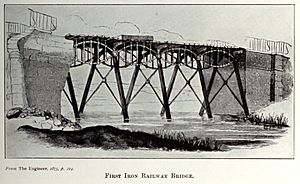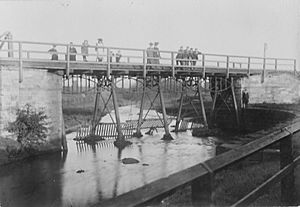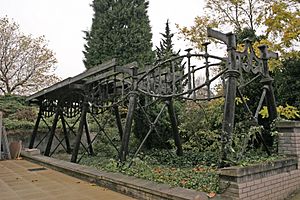Gaunless Bridge facts for kids
Quick facts for kids Gaunless Bridge |
|
|---|---|

Engraving published in The Engineer (1875)
|
|
| Coordinates | 54°38′00″N 1°42′46″W / 54.633203°N 1.712808°W |
| Carries | Witton Park branch of the Stockton and Darlington Railway, a horse-drawn mineral railway |
| Crosses | River Gaunless |
| Characteristics | |
| Design | lenticular truss |
| Material | wrought- and cast-iron |
| Total length | 50 feet (20 m) |
| Longest span | 12 feet 5 inches (3.78 m) |
| Number of spans | three, later four |
| History | |
| Designer | George Stephenson |
| Fabrication by | John & Isaac Burrell |
| Opened | 1823 |
The Gaunless Bridge was a very early railway bridge. It was built in 1823 for the Stockton and Darlington Railway. This bridge was special because it was one of the first railway bridges made of iron. It was also the first to use a unique "lenticular truss" design.
Contents
Where Was the Bridge Located?
The Gaunless Bridge crossed the River Gaunless. This river is near West Auckland in County Durham, England.
The bridge was not on the main railway line. Instead, it was on a smaller branch line. This branch went west from Shildon to serve the Witton Park Colliery, a coal mine.
This branch line had two special sections called "incline railways." These were steep slopes where wagons were pulled up by ropes. Between these slopes, horses pulled the wagons. This meant the bridge only needed to hold the weight of horse-drawn trains. Even so, an old picture shows a steam locomotive on the bridge. This might have been for a test or a demonstration.
How Was the Bridge Designed?
The bridge was designed in 1823 by George Stephenson. He was the main engineer for the railway.
The Gaunless Bridge was one of the first railway bridges made of iron. It was also the first to use a "lenticular truss" design. This design looks like a lens or an eye shape. It uses two curved beams, one above and one below.
The top beam is pushed together (in compression). This is like an arch bridge. The bottom beam is pulled apart (in tension). This is like a suspension bridge. The clever part is that these forces balance each other out. This means the bridge doesn't push much sideways on its supports. So, it only needed simple piers (the vertical supports).
Vertical pieces connect the two curved beams. These pieces support the bridge's deck, where the trains ran. They also help keep the lens shape. A good truss design spreads the weight evenly. This means no single part has to be super strong.
The lenticular truss design has been used for other bridges. However, it never became very popular. Famous engineer Brunel later used a similar design. He used it for bridges like the Chepstow and Saltash.
The Gaunless Bridge was unusual because its wooden deck was above the main curved beams. Most lenticular bridges have their deck hanging below the beams.
Stephenson understood the strengths of different types of iron. He used wrought iron for the curved beams. Wrought iron is strong when pulled. The vertical pieces were made of cast iron. Cast iron is strong when pushed. Because the deck was above the beams, these vertical pieces were pushed together. This allowed Stephenson to use the cheaper cast iron for them. This design was smart and saved money.
Each section of the bridge was about 3.78 meters (12.4 feet) wide. It was about 1.5 meters (5 feet) deep. The supports for the bridge were made of two leaning cast iron pillars. These pillars were braced together with an X-shaped frame.
The bridge first had three sections, or spans. Later, it was made longer to have four spans. This extra space helped floodwater pass underneath. The bridge also had five metal piers for its four spans. The ends of the outer spans rested on iron pillars, not just stone walls. This made the bridge easy to take apart and put back together. This was helpful when it was moved to a museum.
History of the Bridge
The first three-span bridge was built by John & Isaac Burrell. Their workshop was in Newcastle, near Stephenson's own factory. The bridge was finished on October 23, 1823.
In the winter of 1824, heavy snow caused flooding. The bridge was damaged even before the railway line opened. It was rebuilt with four spans in 1825. This was just in time for the railway line to open in September.
Passenger trains started using the line in 1833. Soon after, steam locomotives began crossing the bridge.
In 1875, a model of the Gaunless Bridge was made. This was for the 50th anniversary of the Stockton and Darlington Railway. You can see this model today at the Science Museum, London.
Removal and Preservation
By 1901, the bridge was too weak for the heavier coal wagons. It was taken apart and stored at Brusselton Colliery. The original stone supports were left in place.
In 1927, the York Railway Museum opened. The bridge was put back together there to celebrate the railway's 100th anniversary. Since 1975, it has been on display at the National Railway Museum in York. For many years, it held an old-style coal wagon. The bridge has now been a museum display longer than it was an active bridge!
In February 2023, Historic England gave money to repair the original stone supports. These supports are still where the bridge used to be. The plan is to add a new bridge deck there. This will connect the site to a walking and cycling path along the Stockton and Darlington Railway.
Similar Bridges
The lenticular truss design was not common. Stephenson's design, with the compression truss below the deck, was even rarer.
- Escomb Bridge
A similar bridge still exists a few miles north of Gaunless Bridge. This is the Escomb Bridge, built in 1842. It was a footbridge for people to cross the Bishop Auckland and Weardale Railway near Escomb. Today, it is used as a bridleway for horses and walkers.
The Escomb Bridge has one pair of lenticular beams. Both the beams and the vertical parts are made of wrought iron. This bridge is a Grade II listed building, meaning it is historically important. It was repaired in 2009.
See also
- Pont-y-Cafnau, an earlier iron bridge from 1793, built for a wagonway




